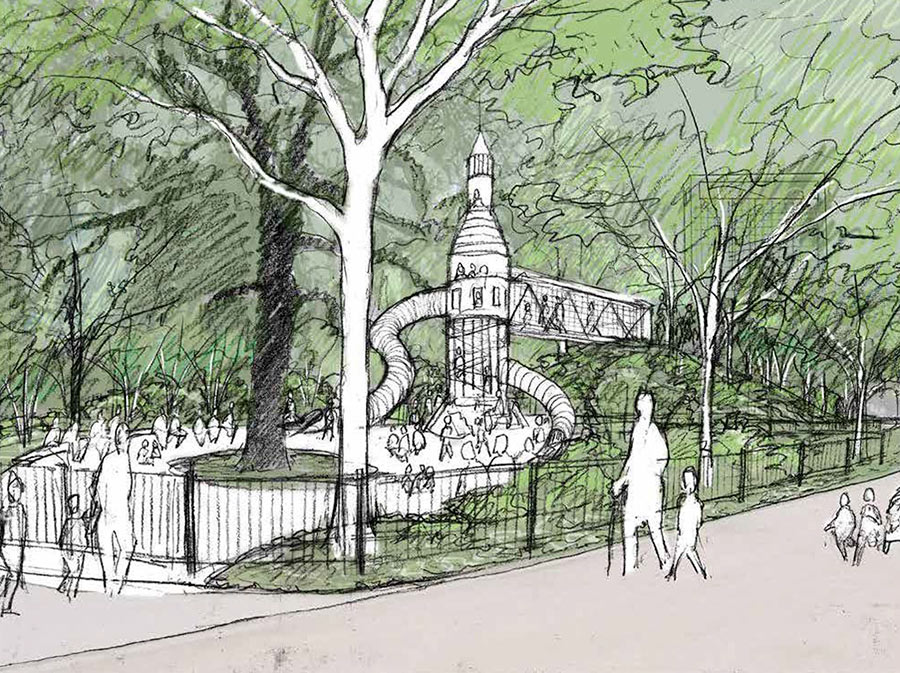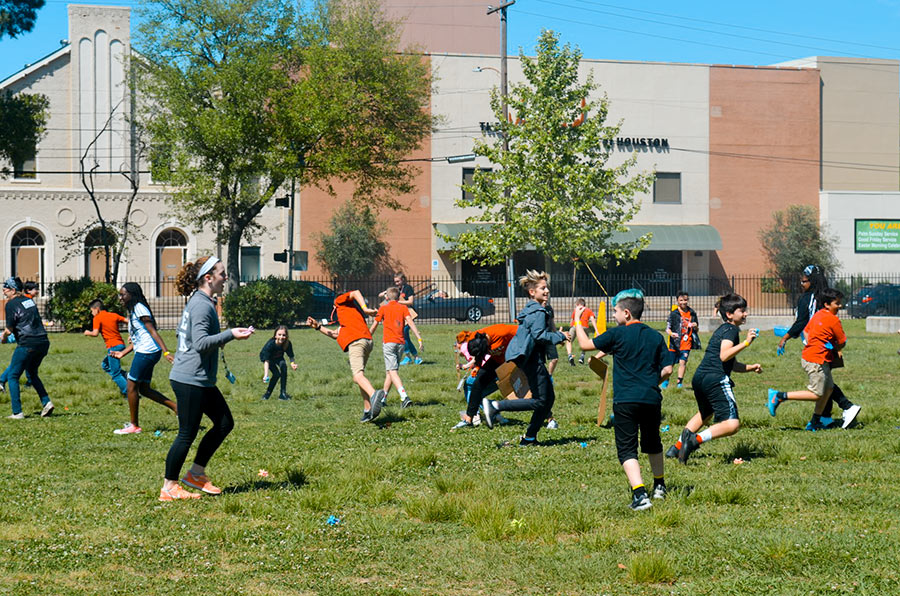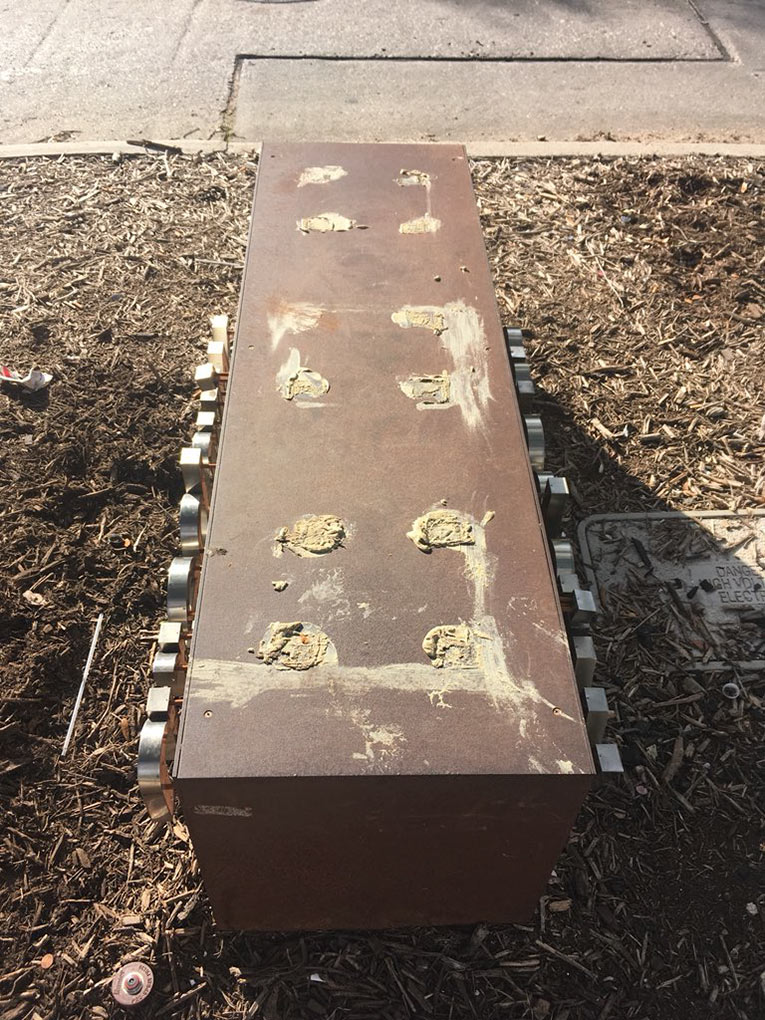CROWDING THE HOUSTON DINNER PLATE “According to USDA maps, we still have about 3.2 million acres of prime farmland within 100 miles of Houston. We can’t produce everything we like and want to eat. No cacao trees for chocolate here, for example. A more relevant question is whether we could supply most if not all of our basic needs from soils within a hundred miles or so. I think the answer is yes. The amount of land to support one person varies in the scientific literature from less than an acre to 20 or so acres. With 4 million people, we would likely need at least 2-4 million acres of farmland. But we are expecting 3.5 million more people by 2035. So not only will there be more people to feed, there will be less land to feed them from, locally. If current density and development practices continue, we can expect to lose at least 1,000 square miles of prime farmland, prairie, and forest habitat to development.” [OffCite]




What?? 4 million people do not eat locally.
The linked-to article is about whether Houston hypothetically could sustain itself.
Sustainability is a buzsword for giving up what you like and enjoy in your daily life.
I happily dismiss stories where people stress sustainability. I’m not going to be guilted into not enjoying my life the way I want.
Oh, kjb, you’ve stuck your foot in it again. Pile on, fellow composters.
kjb434: I was thinking the same thing.
This guy sounds like he’s hoping for energy prices to skyrocket so that he can live in his “city on a plain” as he calls it.
He wants to “have a connection with local soil through the food I eat”. You know, you can plant a garden right now. No one is stopping you. You don’t need higher energy prices to do it. My parents made me work in the garden every day when I was a kid. I guess pulling nutgrass out of the ground for hours and hours gave me a connection to the soil. I didn’t even realize how lucky I was.
I hear ya jgriff.
My parents made sure I knew a lot about gardening. We grew tomatoes so we can have them year round. Add in the citrus trees, broccoli, cuccumbers, eggplants, and shallots and you garden a lot.
The reality is that whether it’s grown 10 miles from your house are 1000 miles makes no difference. Go tell the people of Calgary that they should sustainably garden locally. Unless you live only on wheat and rapeseed (Canola oil), you’ll have a pretty desolate plate of veggies.
Modern farming has allowed people to live in dense cities far away or to live a life where worrying about having food isn’t a problem. Should we tell the people starving people of Africa they should be sustainable. Most of their food is flown in from the US because their lands can’t produce the food they need (personally they should move).
Drivel, nearly every point of it. (1) Soil did not determine the location of Texas’ major cities. Austin and San Antonio were founded by government decree, Houston’s location was the furthest navigable point along a stream. Dallas was a trading post located at a natural ford of the Trinity River. (2) Coastal prairie has black soil, but is not the same as blackland prairie. (3) I’d challenge anybody who claims to be able to run their hands through gumbo clay “like a knife through butter”. (4) Non-prime farmland is still productive and can be improved to dramatically increase crop yields. (5) Why should the limit on “local” be 100 miles? Why not 150? Why not 75? It’s arbitrary. (6) Houston’s regional population is presently closer to six million, not four million. And if we’re using a 100-mile radius to define what is considered local, then we’re probably closer to seven million. (7) Depending on which scientific literature is used, the regional population as defined by the arbitrary 100-mile radius already likely exceeds the estimated carrying capacity of prime farmland by between 2.19 and 43.75 times. The author’s optimism is based upon an underestimation of population and the use of absolute maximum crop yields and is buoyed only…possibly…if I were to include the productive potentials of non-prime farmlands and even backyard agriculture along with enforcable vegetarianism and a diet consisting of mostly high-yield grain crops. (8) The author’s scenario of fuel prices leading to agricultural price inflation sufficient to destroy the globalized system of agriculture ignores impacts to other facets of life. We’re probably talking about $1,000+ per barrel of oil, an immense local labor shortage, and land prices that are rocketing upward to reflect a burgeoning population. Intensive agriculture doesn’t fit that paradigm, at least not here. (9) Frankly, though, I doubt that globalized agriculture could be broken even if it shifted entirely to non-fossil-fuel energy sources. Transportation costs as a percentage of total agricultural costs simply aren’t that big of a deal. (10) Most everything else in the article was the author romantically emoting over the prospect of a return to 19th century urban form with absolutely no basis in reality.
Great post TheNiche! Where I gardened with my family in Louisiana was the same black gumbo clay. The soil has to be worked considerably to make it good for growing some crops.
Your post really pours some common sense on the drivel that comes out of these “sustainability” folks’ mouths.
I second the kudos to Niche on his thorough posting!
It is surely a shame when rich, productive farmland is concreted for streets & new-home slabs…
Yet none of us can subsist on a city lot – even with the richest soil and the mildest climate. That requires economics and that requires a community.
Some of TheNiche’s points are definitely on target. A serious study that takes into account various scenarios — regional population, prime farmland and non-prime farmland, length of the radius, different fuel prices, more refined estimates of productivity — would be great. The point of the article was to raise those questions for a general reader not to present a definitive quantitative study.
His conclusion isn’t optimistic. He writes that he thinks Houston could feed itself but that capacity could easily be lost if it is still there at all.
Food security is already a pressing concern in many places. Last year when oil prices peaked, there were food riots all over the world.
Now, to go through the points in order. (1) Decrees might officially establish a city but the resources like oil or soil or ports or trade routes draw people. (2)The piece makes a distinction between coastal and Texas blacklands in the first paragraph. (3) Few people have ever seen or felt local soil that hasn’t been degraded. Visit the Katy Prairie Conservancy where they have a few patches. (4)A longer quantitative piece could factor in non-prime farmland but the general point about land use is the same. (5)Good question about the length of the radius, but 100 miles is a nice round number that can easily be contrasted with food from Chile. (6 and 7) See point above about an in-depth quantitative study. (8 and 9) The global food system is already failing. In the US we have soaring rates of obesity and in large parts of the world huge numbers of people, around 1 billion, don’t have enough to eat. Is $1,000 per barrel of oil such an impossible scenario over the next 100 years? 10) How can anyone point fingers about the reality of an urban form right now when US banking, real estate, and development practices just brought the entire world to its knees? It is as if TheNiche isn’t reading the blog that he or she is posting on.
The rise in oil price causing food famines aren’t necessarily directly linked, but the are linked nonetheless.
For example, corn and corn based foods that feed much of the world was dealt a blow through the environmental causes championing corn based ethanol for a fuel source. The force many farmers in the US to switch from sweet corn (typical for food consumption) to a corn more associated with feed which is also used for ethanol production. This didn’t necessarily produce a corn shortage, but knowledge of the change type of corn planted blew up the commodities market price for corn. The assumption was a shortage of sweet corn. The price changed cause a shortage.
A solution to the shortage was rice which is another crop the US helps feed the world since we produce so much of it. Well, since rice was going to be so popular the commodity price for it shot up.
Other grains also shot up (but not as much) due to general concerns of shipping cost. This increase is more due to the oil price itself.
Many people instantly blamed speculators and commodity traders. The reality is they were reacting to information (which may or may not have been overblown). The problem still sits with public policy being implemented with not real backing. Ethanol was pushed (bipartisan support) because of a big farm lobby. Ethanol has no net environmental benefit. A gallon of the corn based fuel takes more energy to produce and get to the pump than a standard gallon of gas. It is also less efficient to use in our vehicles.
Much of this has subsided because the commodity hysteria was realized for what is was. It also happens that oil prices dropped also. If oil prices rise again (which they have), the commodity prices will not likely jump again. Their price fluctuation will likely go up or down from more pertinent information such as weather.
The reality is that building cities based upon sustainability in farming never produced large urban centers. transport of grains and other food long distances have been a cornerstone of human civilization since man could utilized a horse and wagon and put goods on ships. Trains helped revolutionize within countries and continents. Unless the entire world will live in small hamlets spread out over farm land (which would get kind of crowded in the end), the concept of sustainability farming supplying adjacent cities is dead. It’s dream not based in reality. To implement any aspect of it would mean that the human behavior would have to ultimately controlled (which has never worked well in any country it has been tried).
To provide responses, point-by-point, in order: (1) Large cities are rarely located somewhere on account of closeness to natural resources. They are located at efficient transhipment points, which are places where transportation routes converge and modes of transportation change. Exceptions to the rule are cities founded by decree, especially to serve as a seat of government or a permanent military post. Natural resource locations only justify small towns or even just temporary encampments that eventually become ghost towns. (2) Describing coastal prairie as blackland is not the local custom. (3) The article is misleading. It claims that the first settlers could run their fingers through the gumbo like a knife through butter. You point out that there exist a handful of acres of such soil (which aren’t open to cultivation) that prove that such soil existed. OK, fine. That’s what the early settlers started with. The article then romanticizes the loss of these soils on account of that they’re getting paved over, as though such soil was still commonplace. But it isn’t. Past and present is being confused in order to tug on people’s heartstrings. (4) I’m not suggesting that a quantitative article is in any way appropriate for Cite, but if you guys are going to put numbers out there at all, the inputs need to be fact-checked and the output needs to pass the sniff test. This doesn’t, and it costs Cite its credibility and relevance. (5) Instead of defending the 100-mile radius because Chile ought to be excluded from a discussion regarding regionally sustainable agriculture, how about defending the 100-mile radius from the elephant in the room that is the Great Plains? Do you believe it the least bit plausible that crops grown there in 100 years will be so costly to move to the coastal population centers that its productive capacity will be rendered irrelevant? (6 and 7) See above point. (8 and 9) The global food system is by no means perfect. There certainly is inequity, but that’s nothing new. Paradigms of regionalism and localism that applied to earlier civilizations were wrought with far greater inequity (and subjected to frequent and devastating local famines). Additionally, commodity price fluctuation and speculation are nothing new. Neither are food riots. These have plauged every civilization within the every relevant paradigm (localism, regionalism, and globalism). You should be more hesitant to criticize globalism. The alternatives are downright scary by modern, comfortable, globalized standards. (10) Straw man. Try again.
Great points about rail and the Great Plains. I’d like to publish letters to the editor along these lines in Cite, and very much hope you will send them to me at mankad at rice dot edu. We have published anonymous blog comments (edited somewhat for tone) but would prefer a letter with a name.